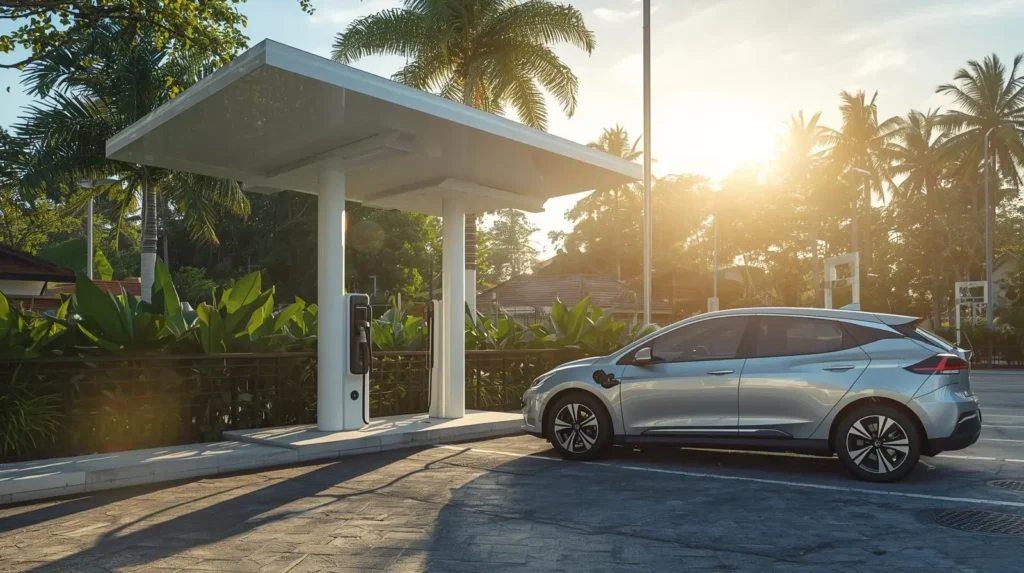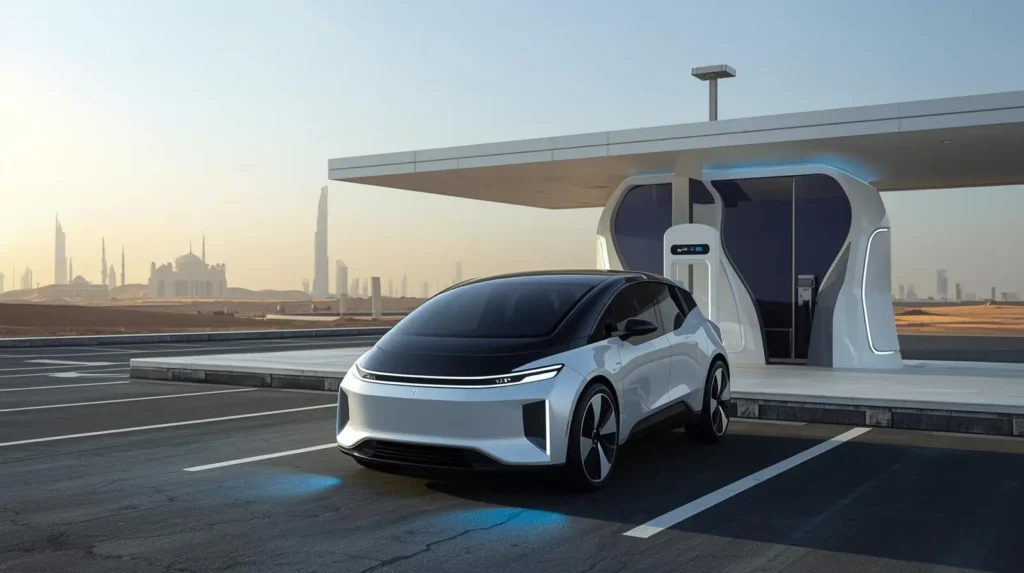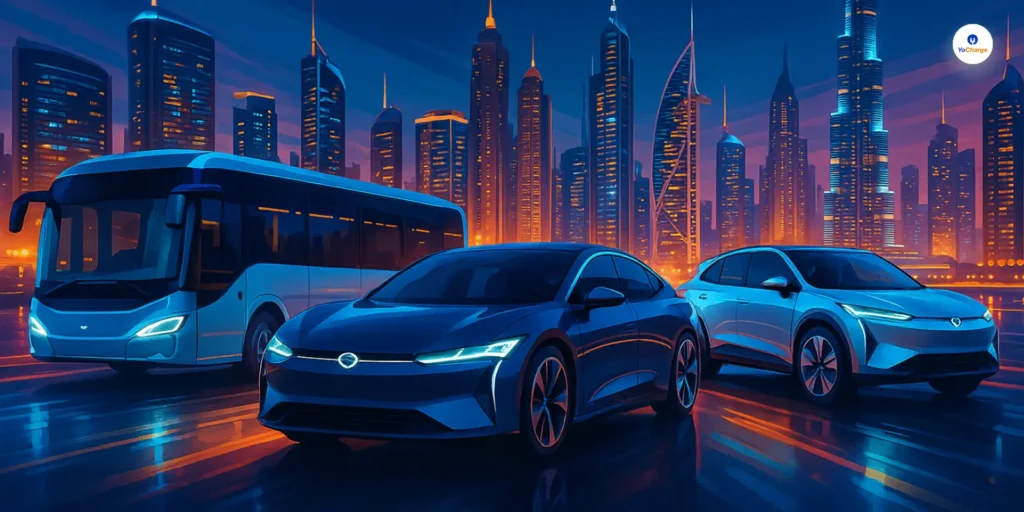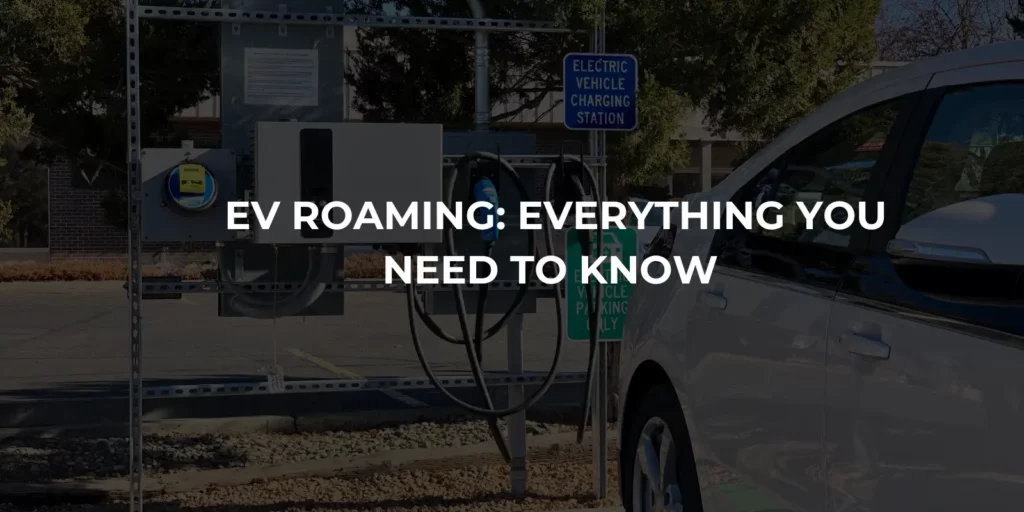
EV Roaming is a rapidly growing trend in the electric vehicle industry, revolutionizing the way drivers access charging infrastructure. With the surge in EV adoption, it becomes crucial to understand the concept of EV Roaming. This blog aims to provide you with an in-depth overview of EV Roaming, its key benefits, and how it is shaping the future of electric transportation. Let’s dive deep into the basics of EV Roaming, how it works and the benefits of using EV Roaming for a seamless and convenient charging experience.
What Is EV Roaming ?
EV roaming is also known as eRoaming. It is a service allowing drivers to charge their electric vehicles (EVs) at public charging stations outside their charging service provider’s network. EV drivers can use one customer account to access charging points across different networks and countries.
EV roaming system allows EV drivers to charge their vehicles conveniently, by providing seamless access to a variety of charging points. It plays a crucial role in the widespread adoption of electric vehicles by addressing one of the key concerns of EV owners: access to charging infrastructure.
With the growth of EV roaming networks, electric vehicle drivers can confidently travel. They can easily find and use charging stations regardless of their location. This accessibility not only enhances the convenience for EV users but also contributes to reducing range anxiety, a common barrier to EV adoption.
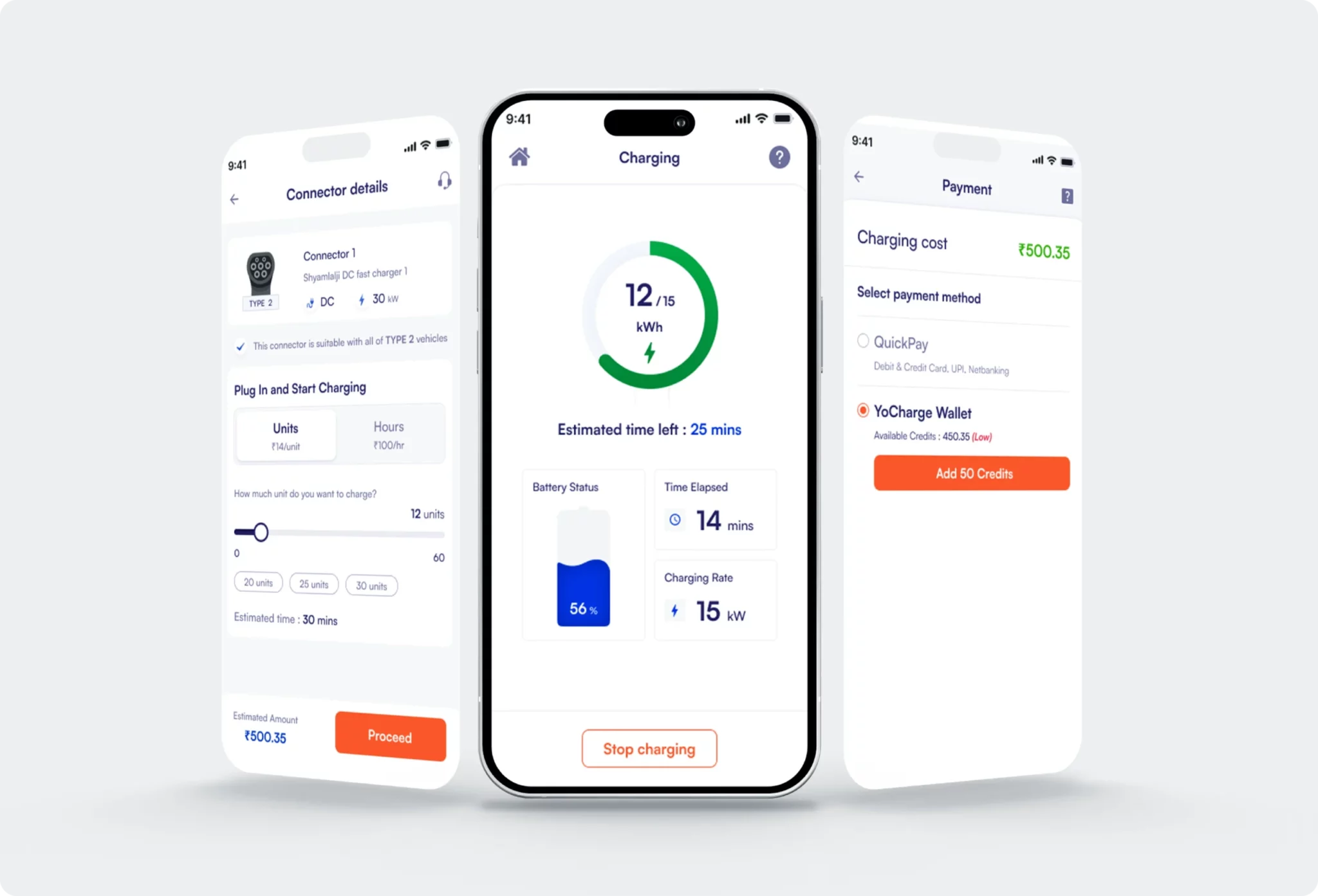
Introducing YoCharge
EV Charging Management Software Company.
For Charge Point Operators, our EV Roaming Software provides ability to integrate with multiple eMSP providers.
For eMSP (EV Roaming Network providers) our white-label eMSP Software enables you to on-board multiple EV charging networks.
To know more about our offerings:
How Does EV Roaming Work?
EV Roaming networks are a collection of charging stations that are interconnected and accessible to EV owners through a single account or payment method. These networks are designed to provide seamless access to charging infrastructure, allowing EV drivers to charge their vehicles at any participating station, regardless of the network they are a member of.
Types Of Charging Stations Available For EV Roaming
There are several types of charging stations available for eRoaming, including:
- DC Fast Charging Stations: These stations can charge an EV battery to 80% capacity in about 30 minutes. They are typically found along major highways and in urban areas.
- Level 1 Charging Stations: These stations can charge an EV battery to 100% capacity in about 8-12 hours. They are typically found in residential areas and are the slowest type of charging station.
- Level 2 Charging Stations: These stations can charge an EV battery to 100% capacity in about 5-8 hours. They are commonly found in residential areas and commercial parking lots.
Process For Accessing And Using EV Roaming Services
To access and use eRoaming services, EV owners need to sign up for a membership with a participating network. Once a member, EV owners can use their account to access charging stations across the network. When an EV owner arrives at an EV charging station, they can use their account to start charging their vehicle.
The charging process is typically automatic, with the charging station recognizing the EV owner’s account and starting the charging process. Once the charging is complete, the EV owner can end the charging session and pay for the charging using their account.
Top 7 Benefits Of EV Roaming
EV Roaming offers several significant benefits to both EV drivers and charging infrastructure providers. Some of the major benefits are mentioned below:
1. Convenience
It provides electric vehicle owners with the convenience of accessing charging stations across different networks using a single account or payment method, making it easier to charge their vehicles while on the go.
2. Accessibility
By offering seamless access to a variety of charging points, eRoaming enhances the accessibility of charging infrastructure for EV drivers, ensuring they can find and use charging stations wherever they are, thereby reducing range anxiety.
3. Long-Distance Travel
It facilitates long-distance travel for electric vehicles by enabling drivers to access charging stations along their route, making it more practical and feasible to undertake extended journeys in an electric vehicle.
4. Interconnected Networks
EV Roaming networks connect various charging stations, promoting interoperability and allowing EV owners to charge their vehicles at different locations without the need for multiple memberships or accounts.
5. Promotes EV Adoption
The availability of eRoaming services encourages more people to switch to electric vehicles by addressing concerns about charging infrastructure, ultimately contributing to the growth of sustainable transportation practices and reducing reliance on traditional fossil fuel vehicles.
6. Freedom From Range Anxiety
EV Roaming eliminates range anxiety, a common concern among EV drivers. It provides access to an extensive network of charging stations across different networks. This empowers drivers to go on longer journeys without the fear of running out of battery power.
7. Increased Utilization for Charging Providers
EV Roaming leads to higher station utilization rates for Charge Point Operators (CPOs) as drivers gain access to more charging options. This increased utilization maximizes revenue for charging providers and ensures that stations are occupied more frequently.

Limitations Of EV Roaming
EV Roaming offers numerous benefits, however, it also faces limitations. The limitations include:
1. Issues Related To Interoperability
One of the challenges facing eRoaming is the lack of seamless interoperability between different charging networks. This can lead to complications for EV owners who may need to manage multiple memberships to access various charging stations. It hinders the convenience and efficiency of the EV charging experience.
2. Availability and Reliability Concerns
In some regions, there are concerns regarding the availability and reliability of EV charging infrastructure, which can impact the effectiveness of EV Roaming services.
Limited access to charging stations or issues with station maintenance and functionality can create obstacles for EV drivers, especially in areas where the charging infrastructure is still developing.
3. Cost Implications for Users
Another limitation of EV Roaming is the potential cost implications for users. While accessing charging stations through a single account can offer convenience, some networks may have different pricing structures or additional fees, leading to varying costs for EV owners depending on the network they use.
This variability in pricing can affect the affordability of electric vehicle ownership and influence drivers’ decisions on utilizing EV Roaming services.
Suggested Reads: How To Start EV Charging Station Business?
Technology Advancements In EV Roaming
Technological advancements in EV roaming aim to provide a seamless and convenient charging experience for EV drivers, while also promoting sustainable transportation practices. Tech advancements in EV roaming include:
- Integration Of Renewable Energy Sources In EV Charging Stations: EV charging stations are being designed to integrate renewable energy sources, such as solar panels, to make the charging process more environmentally friendly.
- Interoperability Between Different Networks: EV roaming networks are being developed to connect various charging networks, allowing EV drivers to access charging stations across different networks using a single account or payment method.
- Expanded Coverage: EV roaming protocols are being implemented to promote the growth of charging infrastructure, making EV adoption more viable by eliminating range anxiety and enabling long-distance travel.
- Efficient Charging: EV roaming protocols optimize charging sessions, ensuring faster and smarter charging for EVs while balancing the load on the grid.
- Sustainability: By simplifying the charging process and promoting EV adoption, EV roaming protocols contribute to reducing carbon emissions and creating a greener future.
How It Works: Understanding The Process

Signing Roaming Documents
To kickstart your journey as a charge point operator, your initial task involves pinpointing the roaming type: be it peer-to-peer roaming or a roaming Hub. This choice lays the groundwork for formalizing crucial terms and agreements.
These documents summarize commercial specifics, technical nuances, support protocols, and other essential criteria.
Relationship With Partner
Roaming agreements enable parties to establish a secure connection and share data. This relationship begins with a “handshake” where both parties exchange credentials to access their roaming databases. Once the connection is established, data can flow in two ways:
- Pushing Data: It involves sending it to the partner’s database and creating an outgoing stream.
- Pulling Data: This means getting data from the partner’s database and creating an incoming stream.
Setting Up Operations
Once you have gathered all the roaming data for the EVSEs (Electrical Vehicles Supply Equipments), it is very important to link it with the appropriate roaming partner in your system.
Roaming partners will periodically access data from your system, typically every 24 hours, to stay updated on the charging stations and transactions.
The Future Outlook Of EV Roaming
The EV Roaming market is expected to witness significant growth in the coming years, driven by several key factors including
Exponential EV Adoption
The global electric vehicle (EV) market is experiencing rapid growth. According to BloombergNEF, global electric vehicle (EV) sales are expected to increase from 10.5 million vehicles in 2022 to 22 million units in 2025. This could account for 40% of global auto sales by 2030, which is more than five times the number of EVs sold in 2022.
This surging demand for EVs creates a critical need for robust and accessible charging infrastructure, including efficient roaming solutions.
Policy Support
Governments worldwide are actively promoting EV adoption through various initiatives such as subsidies, tax breaks, and substantial investments in charging infrastructure development. These policies are expected to further accelerate EV growth, consequently propelling the demand for seamless roaming services.
Technological Advancements
Continuous advancements in battery technology, charging infrastructure, and digital platforms are expected to enhance the efficiency and convenience of EV charging. This will play a vital role in driving the adoption of EV roaming services.
Advancements And Trends Shaping The Future Of EV Roaming
The future of EV roaming is predicted to be characterized by the following factors:
- Enhanced Convenience And Accessibility: Streamlined user experiences are anticipated, with features like automated payment systems, real-time availability information, and integrated navigation to charging stations. This will significantly improve the ease and convenience of using public charging infrastructure across different networks.
- Interoperability And Standardization: Increased collaboration among industry stakeholders is expected to address interoperability challenges. This will involve establishing standardized protocols and communication interfaces, enabling seamless roaming across different charging networks and providers.
- Focus On Sustainability: The emphasis on renewable energy integration and green charging solutions is expected to gain further traction. This could involve incorporating solar panels at charging stations, utilizing smart grid technologies, and offering renewable energy certificates to EV drivers.
- Integration With Advanced Technologies: The future of EV roaming is likely to witness the integration of advanced technologies like blockchain and artificial intelligence (AI). Blockchain can enhance security and transparency in transactions, while AI can optimize charging processes and offer personalized recommendations to users.
Suggested Reads: What Is AutoCharge In EV Charging?
The Final Words
In conclusion, this blog has provided a comprehensive overview of EV Roaming, covering everything you need to know about this important topic. From the basics of EV Roaming to its benefits and challenges, we have explored the key aspects that will help you understand this technology and its impact on the future of electric vehicles. Whether you’re a seasoned EV enthusiast or just getting started with electric cars, it is crucial to stay informed about EV Roaming as it continues to shape the way we drive and charge our vehicles. To further expand your knowledge on this subject, we encourage you to check out the related resources available.
If you are currently looking for the perfect solution for your EV Charging business, then you are at the right place. YoCharge White label EV Charging Management Software is an All-in-one platform for your EV Charging business. To discover its top features and functionality you can easily schedule a demo.
